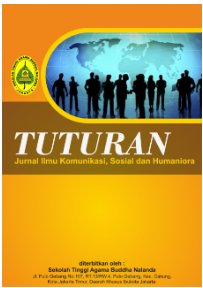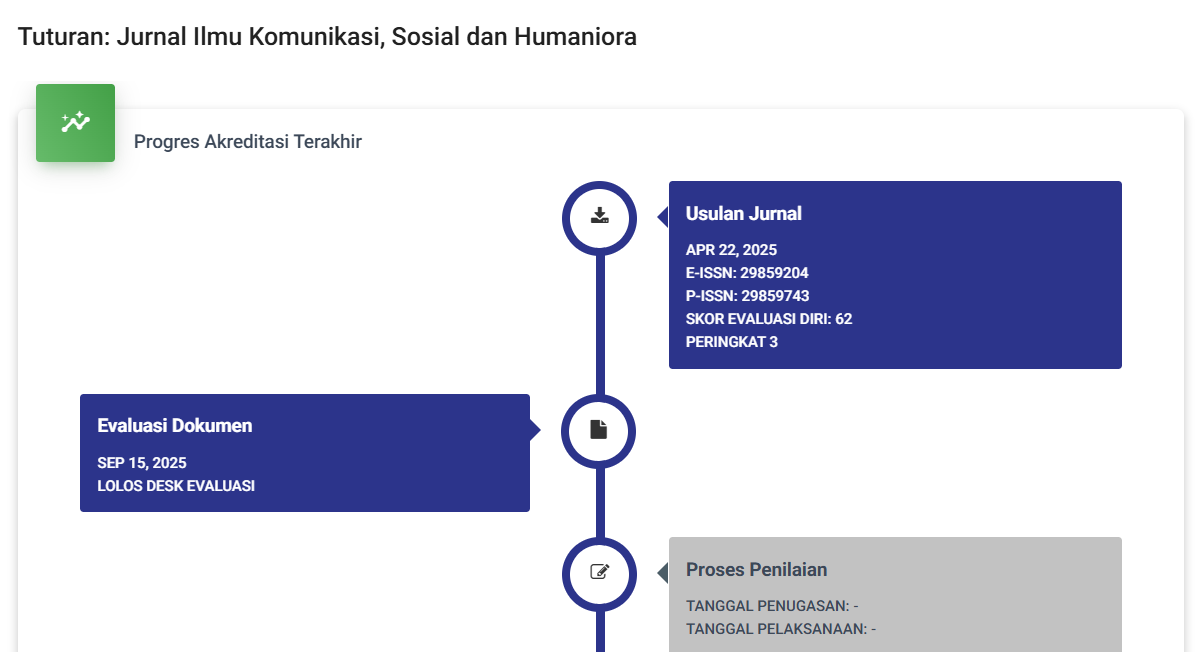Integrated Marketing Communication dalam Mempromosikan Wisata Waduk Gajah Mungkur di Era Digital
DOI:
https://doi.org/10.47861/tuturan.v2i4.1304Keywords:
Integrated Marketing Communication, Digital Marketing, Promotional Mix, DISPORA, Gajah Mungkur Reservoir Tourism.Abstract
Tourism plays a crucial role as a key driver of economic growth and national development, making the planning and promotion of this sector essential. This study aims to analyze the Integrated Marketing Communication (IMC) strategies implemented by DISPORA in promoting tourism at the Gajah Mungkur Reservoir in the digital era. A qualitative approach was employed to illustrate the IMC strategies used to attract visitors. The findings of the study indicate that DISPORA's IMC strategy has been successful in building a strong brand image and attracting tourists through word-of-mouth marketing, social media platforms (Instagram and Facebook), and consistent messaging across channels. Notably, the use of social media as the primary platform has proven effective in capturing visitor interest through engaging visual content. However, the study also identifies weaknesses in sales promotion efforts, such as the lack of discounts and loyalty programs. To enhance the effectiveness of their campaign, it is recommended that DISPORA improve the quality of digital content, provide staff training on digital technology and social media, and collaborate with influencers to expand promotional reach.
References
Andini, T., & Kurniawan, F. (2020). Analisis pembentukan ekspektasi wisata lewat fitur pendukung pencarian informasi di Instagram. Jurnal Studi Komunikasi, 4(2), 503-523.
Bala, M., & Verma, D. (2018). A critical review of digital marketing. International Journal of Management, IT & Engineering, 8(10), 321-339.
Batra, R., & Keller, K. L. (2016). Integrating marketing communications: New findings, new lessons, and new ideas. Journal of Marketing, 80(6), 122-145.
Belch, G. E., & Belch, M. A. (2018). Advertising and promotion: An integrated marketing communications perspective. McGraw-Hill.
Bogdan, R., & Taylor, S. J. (1990). Looking at the bright side: A positive approach to qualitative policy and evaluation research. Qualitative Sociology, 13(2), 183-192.
Buhalis, D. (2000). Marketing the competitive destination of the future. Tourism Management, 21(1), 97-116.
Camilleri, M. A., & Camilleri, M. A. (2018). Integrated marketing communications (pp. 85-103). Springer International Publishing.
Castells, M., Fernandez-Ardevol, M., Qiu, J. L., & Sey, A. (2009). Mobile communication and society: A global perspective. MIT Press.
Chaffey, D., & Ellis-Chadwick, F. (2019). Digital marketing. Pearson UK.
Chu, S. C., & Kim, Y. (2011). Determinants of consumer engagement in electronic word-of-mouth (eWOM) in social networking sites. International Journal of Advertising, 30(1), 47-75.
De Bruyn, A., & Lilien, G. L. (2008). A multi-stage model of word-of-mouth influence through viral marketing. International Journal of Research in Marketing, 25(3), 151-163.
Dewi, K., Angligan, I. G. K. H., & Mahardika, I. M. N. O. (2023). Strategi meningkatkan peran media sosial dalam membranding destinasi wisata sebagai media pemasaran. Waisya: Jurnal Ekonomi Hindu, 2(1), 1-11.
Etikan, I., Musa, S. A., & Alkassim, R. S. (2016). Comparison of convenience sampling and purposive sampling. American Journal of Theoretical and Applied Statistics, 5(1), 1-4.
Firmansyah, M. A. (2019). Pemasaran: Dasar dan konsep. Penerbit Qiara Media.
Garrod, B., & Fyall, A. (2017). Collaborative destination marketing at the local level: Benefits bundling and the changing role of the local tourism association. Current Issues in Tourism, 20(7), 668-690.
Graci, S. (2020). Collaboration and partnership development for sustainable tourism. In Tourism and Sustainable Development Goals (pp. 232-249). Routledge.
Hanna, R., Rohm, A., & Crittenden, V. L. (2011). We’re all connected: The power of the social media ecosystem. Business Horizons, 54(3), 265-273.
Hays, S., Page, S. J., & Buhalis, D. (2013). Social media as a destination marketing tool: Its use by national tourism organisations. Current Issues in Tourism, 16(3), 211-239.
Hendra, T., & Musliadi, P. (2019). Prinsip dan unsur-unsur komunikasi dalam perspektif Al-Quran. Wardah, 20(2), 12-31.
Hernández-Mogollón, J. M., Folgado-Fernández, J. A., & Duarte, P. A. O. (2014). Event tourism analysis and state of the art. European Journal of Tourism, Hospitality and Recreation, 5(2), 83-102.
Indrapura, P. F. S., & Fadli, U. M. D. (2023). Analisis strategi digital marketing di perusahaan Cipta Grafika. Jurnal Economina, 2(8), 1970-1978.
Isdarmanto, I. (2020). Strategi branding pengembangan industri pariwisata 4.0 melalui kompetitif multimedia di era digital. Journal of Tourism and Creativity, 4(1), 1-20.
Išoraitė, M. (2016). Marketing mix theoretical aspects. International Journal of Research-Granthaalayah, 4(6), 25-37.
Keller, K. L. (2016). Unlocking the power of integrated marketing communications: How integrated is your IMC program?. Journal of Advertising, 45(3), 286-301.
Kern, F. G. (2018). The trials and tribulations of applied triangulation: Weighing different data sources. Journal of Mixed Methods Research, 12(2), 166-181.
Kim, H., Sefcik, J. S., & Bradway, C. (2017). Characteristics of qualitative descriptive studies: A systematic review. Research in Nursing & Health, 40(1), 23-42.
Kitchen, P. J., & Burgmann, I. (2010). Integrated marketing communication. In Wiley International Encyclopedia of Marketing.
Koerniawati, F. T. (2022). Destinasi wisata, sumber daya manusia pariwisata dan pariwisata berkelanjutan. Siwayang Journal: Publikasi Ilmiah Bidang Pariwisata, Kebudayaan, dan Antropologi, 1(1), 39-50.
Kotler, P., & Keller, K. L. (2007). Manajemen pemasaran (Edisi ke-12, Jilid 1). PT. Indeks.
Kotler, P., & Keller, K. L. (2016). Marketing Management (15th ed.). Pearson Education.
Kurniawanti, D., & Hendrawan, B. (2017). Analisis strategi komunikasi pemasaran PT. Indonesia Villajaya dalam upaya membangun loyalitas pelanggan. Journal of Applied Business Administration, 1(1), 61-73.
Kusumasari, R. N., & Afrilia, A. (2020). Strategi komunikasi pemasaran terpadu J&C Cookies Bandung dalam meningkatkan penjualan. Jurnal Sains Manajemen, 2(1), 97-103.
Lestari, S., Samihardjo, R., & Sapanji, R. V. T. (2023). Pelatihan brand identity untuk UMKM: Meningkatkan kesadaran merek dan daya saing di era digital. Abdimasku: Jurnal Pengabdian Masyarakat, 6(2), 490-499.
Mangold, W. G., & Faulds, D. J. (2009). Social media: The new hybrid element of the promotion mix. Business Horizons, 52(4), 357-365.
Mardiyanto, D., & Giarti, G. (2019). Analisis strategi komunikasi pemasaran (studi kasus strategi komunikasi pemasaran merchandise di Kedai Digital 8 Solo). Jurnal Ilmiah Edunomika, 3(01), 60-66.
Miles, M. B., & Huberman, A. M. (1992). Analisis data kualitatif. UI Press.
Mulyana, D. (2002). Ilmu komunikasi: Suatu pengantar. Remaja Rosdakarya.
Mulyansyah, G. T., & Sulistyowati, R. (2021). Pengaruh digital marketing berbasis sosial media terhadap keputusan pembelian kuliner di kawasan G-Walk Surabaya. Jurnal Pendidikan Tata Niaga (JPTN), 9(1), 1097-1103.
Musleh, M. (2023). Tata kelola wisata Pulau Gili Iyang: Perspektif community based tourism. Journal of Contemporary Public Administration (JCPA), 3(1), 42-50.
Namugenyi, C., Nimmagadda, S. L., & Reiners, T. (2019). Design of a SWOT analysis model and its evaluation in diverse digital business ecosystem contexts. Procedia Computer Science, 159, 1145-1154.
Nath, P., Nachiappan, S., & Ramanathan, R. (2010). The impact of marketing capability, operations capability and diversification strategy on performance: A resource-based view. Industrial Marketing Management, 39(2), 317-329.
Nurhajati, N. (2018). Dampak pengembangan desa wisata terhadap peningkatan kesejahteraan masyarakat (studi di desa Mulyosari kecamatan Pagerwojo kabupaten Tulungagung). Publiciana, 11(1), 1-13.
Palattella, M. R., Dohler, M., Grieco, A., Rizzo, G., Torsner, J., Engel, T., & Ladid, L. (2016). Internet of things in the 5G era: Enablers, architecture, and business models. IEEE Journal on Selected Areas in Communications, 34(3), 510-527.
Pine, B. J., & Gilmore, J. H. (1998). Welcome to the experience economy. Harvard Business Review, 76(4), 97-105.
Pop, R. A., Săplăcan, Z., Dabija, D. C., & Alt, M. A. (2022). The impact of social media influencers on travel decisions: The role of trust in consumer decision journey. Current Issues in Tourism, 25(5), 823-843.
Porcu, L., del Barrio-García, S., & Kitchen, P. J. (2012). How Integrated Marketing Communications (IMC) works? A theoretical review and an analysis of its main drivers and effects. Communication & Society, 25(1), 313-348.
Purwanti, N. D. (2014). Pengaruh jumlah kunjungan wisatawan terhadap pendapatan asli daerah Kabupaten Mojokerto tahun 2006-2013. Jurnal Pendidikan Ekonomi (JUPE), 2(3), 1-12.
Rajhans, K. (2018). Effective communication management: A key to stakeholder relationship management in project-based organizations. IUP Journal of Soft Skills, 12(4), 47-66.
Roudhonah. (2007). Ilmu komunikasi. UIN Jakarta.
Saliu, H. (2020). Public diplomacy and related concepts from the perspective of Lasswell’s communication model. Jahr–European Journal of Bioethics, 11(2), 357-376.
Sapienza, Z. S., Iyer, N., & Veenstra, A. S. (2018). Reading Lasswell's model of communication backward: Three scholarly misconceptions. In Advances in Foundational Mass Communication Theories (pp. 38-61). Routledge.
Schmitt, B. (1999). Experiential marketing. Journal of Marketing Management, 15(1-3), 53-67.
Scholl, B. J. (2001). Objects and attention: The state of the art. Cognition, 80(1-2), 1-46.
Šerić, M., Ozretić-Došen, Đ., & Škare, V. (2020). How can perceived consistency in marketing communications influence customer–brand relationship outcomes?. European Management Journal, 38(2), 335-343.
Siagian, A. O., & Cahyono, Y. (2021). Strategi pemulihan pemasaran UMKM di masa pandemi COVID-19 pada sektor ekonomi kreatif. Jurnal Teknologi Dan Sistem Informasi Bisnis, 3(1), 206-217.
Situmorang, S. H., Mulyono, H., & Berampu, L. T. (2018). Peran dan manfaat sosial media marketing bagi usaha kecil. Asian Journal of Entrepreneurship and Family Business, 1(2), 77-84.
Sudiarta, I. N., Suardana, I. W., & Ariana, N. (2014). Persaingan daya tarik pariwisata Bali: Suatu kajian konseptual dan empiris. Jurnal Perhotelan dan Pariwisata, 4(1), 1-13.
Sugiyono. (2016). Metode penelitian kuantitatif, kualitatif, dan R&D. Alfabeta.
Tangkudung, A. G. D., Rante, J. Z., Pakpahan, M., Putri, A., Puteri, A., Pribadi, D., ... & Bassuni, W. (2024). Inovasi bisnis pariwisata Indonesia pasca pandemi COVID-19. Jurnal Pendidikan Tambusai, 8(1), 657-667.
Thurmond, V. A. (2001). The point of triangulation. Journal of Nursing Scholarship, 33(3), 253-258.
Tuten, T. L. (2023). Social media marketing. Sage Publications Limited.
Utami, F. I. D. (2017). Efektivitas komunikasi negosiasi dalam bisnis. Komunike, 9(2), 105-122.
Wardhana, A., Kharisma, B., & Stevani, M. (2019). Dampak sektor pariwisata terhadap pertumbuhan ekonomi (TLG hipotesis, studi kasus: 8 negara ASEAN). E-Jurnal Ekonomi dan Bisnis Universitas Udayana, 8(10), 1193-1208.
Widowati, I., Riany, D. A., Andrianto, F., & Suhartini, S. (2022). Analisis SWOT untuk pengembangan bisnis kuliner (studi kasus pada UMKM Papat Sodara Food Purwakarta). Jurnal Teknologika, 12(1), 146-156.
Downloads
Published
How to Cite
Issue
Section
License
Copyright (c) 2024 TUTURAN: Jurnal Ilmu Komunikasi, Sosial dan Humaniora

This work is licensed under a Creative Commons Attribution 4.0 International License.








